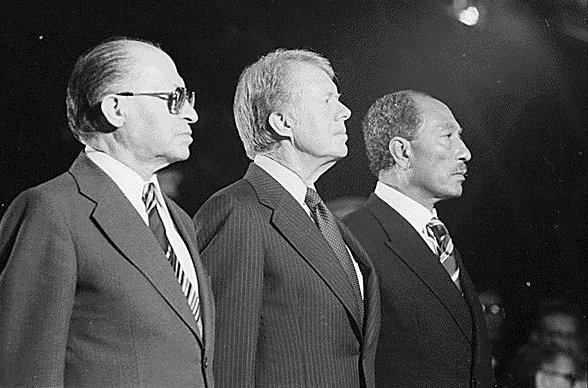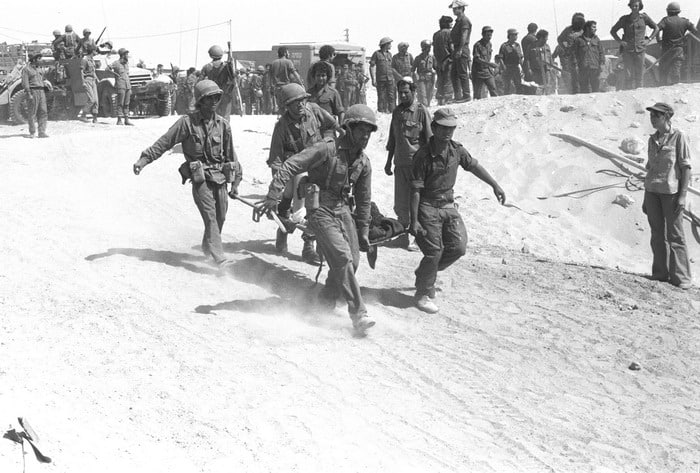Key Facts & Summary
- The Yom Kippur War was a damaging and inconclusive armed conflict fought from the 6th to the 25th of October, 1973, between Israel and an Arab coalition composed mainly of Egypt and Syria.
- It was the Fourth Arab-Israeli war and earned its name by taking place on the Jewish holy day of Yom Kippur. This coincided with the Muslim observance of Ramadan, which took place between28 September and 26 October in 1973.
- The conflict began with the sudden attack of the Egyptian and Syrian armies. Such aggression took the Israeli political and military leadership by surprise and placed Israel’s armed forces in great difficulty. The Egyptian troops, which were well equipped with Soviet anti-tank and anti-aircraft missiles, successfully crossed the Suez Canal.
- Despite great losses on the side of Egypt, they were able to push back Israeli counter-attacks. Meanwhile, the Syrian forces occupied the Golan Heights. However, following fierce combat, the Israelis managed to defeat the Syrian tanks in the Golan Heights, but at great cost.
- The war drew the United States (in defence of Israel) and the Soviet Union (in defence of Syria) into indirect conflict with each other during a period of peace between the two superpowers.
- The war ended without resolutive results from the military point of view. However, it demonstrated that the Arabs were able to defend themselves from Israel and Israel was not infallible.
- In Israel, the sudden war caused strong political controversies that culminated in the resignation of Prime Minister Golda Meir, the Defense Minister Moshe Dayan, and Chief of Staff David Elazar.
Overview
The war is also known as the October War because of the month it occurred in, the Ramadan War, because it took place during the Muslim observance of Ramadan, or the Fourth Arab-Israeli War, as it was the fourth major conflict between the belligerents. The conflict began when Egypt and Syria respectively launched surprise attacks on October 6, 1973, in Sinai and the Golan Heights. These were territories that Israel had conquered in 1967 during the Six Days War.
The Egyptian and Syrian forces advanced during the first 24-48 hours of the conflict by taking advantage of the holy observance of Yom Kippur by Jewish Israelis, after which the situation devolved into a stalemate before turning to Israel’s advantage. During the second week of the war, the Syrians had been completely defeated and were pushed out of the Golan Heights.
In South Sinai, the Israelis had attacked the communication points between the two Arab armies and had, in turn, entered the Egyptian territory after passing the Suez Canal (which served as a frontier before October 6). At the time of the ceasefire, although they still possessed a strong missile system, the Egyptian army was cut off from any supply line and did not have contact with the other Arab countries.
The conflict had long-term implications for many countries. The Arab world, which felt humiliated by the complete defeat during the Six-Day War, was able to feel psychologically satisfied by the victories obtained in the first part of the battle. This didn’t last long, however, as the situation slowly turned in favour of the Israeli army. Both the Egyptians and Israelis demonstrated intelligent strategies throughout the combat.
The reason for the degree of surprise that accompanied the initial assault came from the fact that Egyptian Muslims were observing Ramadan, a time of peace, prayer and fasting, while in Israel, Jewish people were observing Yom Kippur, which also involved prayer, fasting and no radio or television for 24 hours. Consequently, Israelis were not aware of the invasion when it began. Only a few thousand Israeli soldiers on duty were on hand to oppose the Arab forces as they are exempt from the observance in defence of the country.
The 1978 Camp David Accords led to the normalisation of the relations between Israel and Egypt, the first Arab nation to recognise the existence of the State of Israel. Egypt, which had already substantially freed itself from Soviet influence and aid, implicitly declared its willingness to break away almost entirely from the USSR.
Causes of the War
One of the factors that caused the conflict was the unsolved territorial problem caused by Israel: during the Six Day War (a pre-emptive strike launched by Israel against Egypt, Jordan, and Syria in 1967), Israel had annexed territories that belonged to the Arabs. Following this very short war, Israel conquered Sinai, the Golan Heights to the north, Transjordan, and east Jerusalem.
The leaders of the war in 1973 were Anwar Sadat (who had recently succeeded Abdel Nasser), and Hafez al-Assad (a Syrian dictator and father of the current dictator, Bashar al-Assad). Both were secular nationalists, exponents of the pan-Arab nationalist movement (this signifies that their defence of Arab communities was not based on their Muslim religion, but on the common belonging to the Arab ethnic group). Pan-Arabism had led the dictators to various experiments such as the United Arab Republic (a union lasting three years between Syria and Egypt) and then the Federation of Arab Republics. However, these experiments failed.
Both countries were confronted with similar problems: Syria and Egypt were facing a difficult economic situation, as well as opposition by internal religious minorities (such as the Muslim Brotherhood in Egypt), and pressure from the most educated and nationalist classes who wanted to take back the territories taken by Israel during the 1967 war. When the great powers decided to maintain the status quo in the Middle East with the Oslo conference, Sadat and Assad took the decision of a surprise attack against Israel.
The war
The date chosen for the attack was October 6th, the day of the Jewish holy day Yom Kippur. It is the most solemn feast of the Jewish calendar, during which the faithful must practice prayer and fasting. The attack also coincided with the Muslim observance of Ramadan that year, which also involves prayer, fasting and abstinence. The almost completely unexpected attack took the Israeli military by surprise and caused significant losses.
Military action began at 2 pm on October 6, 1973. That morning, Golda Meir, the Israeli Prime Minister, met with her generals. She was warned that Syria and Egypt, and perhaps Jordan, would likely launch an attack soon. Meir refused to launch a pre-emptive attack claiming that if Israel attacked first they would lose their chance of getting aid from the West.
The Egyptians crossed the Suez Canal and on the first day of the war, they brought 100,000 men and about 1500 tanks onto the Israeli shore. The Syrians were also successful, since they managed to occupy the Golan Heights on the first day of the conflict. Because of its airforce, equipped with modern American aircraft, the Israeli populace believed that the military would to be able to stop any invasion in advance.
However, Egypt was equipped with Soviet anti-aircraft missiles – the SAMs (the same missiles that had knocked down the plane of former presidential candidate John McCain in Vietnam). Such weapons outweighed Israel’s initial advantage, forcing the country to fight a bloody land war.
In the early days of the battle especially, Israel’s losses were very serious. Israeli tanks were launched against Egyptian and Syrian divisions in a desperate attempt to slow down its advance, while the rest of the army was mobilised. Substantial numbers of Israeli tanks were destroyed and troops killed by new Soviet anti-tank weapons. Meanwhile, Israel’s cities were faced with continuous blackouts, and sirens warned against the arrival of Egyptian and Syrian planes. For a few days, the Israelis felt that the war could lead to defeat and, perhaps, to the end of their state.
Within a week, however, the Israeli army managed to reorganise itself and exploit its organisational and technological superiority. The Golan Heights were regained and, on October 14, after a week of very hard fights, some Israeli tanks passed the Suez Canal entering Egyptian territory in order to force a cease-fire. The counterattack was led by General Ariel Sharon, who many years later became the country’s Prime Minister. It was an event that was celebrated in Israel as a national holiday. Eight days later, the UN imposed a ceasefire. The hostilities ended definitively on October 28.
Consequences
In 22 days of combat, about 15,000 soldiers died (of which two thousand were Israelis), and almost 40,000 soldiers were injured. Despite the final defeat, the successes that the Egyptian army reported at the beginning of the war helped to restore Egyptian nationalists’ confidence. Despite the regained confidence, many Arab leaders were convinced that Israel could not be beaten militarily and this, according to historians, encouraged peace negotiations.
In particular, Egypt began to normalise relations with Israel after the war and the conclusion of the peace treaty between the two nations in 1979 led to the expulsion of Egypt from the Arab League, which lasted until 1989. A few years after the peace signing, the Egyptian dictator Al-Sadat was killed in an attack. The oil-producing countries, in response to American aid granted to Israel, began an embargo on the United States and many other Western countries, which lasted until 1974. The price of oil increased by 400% and this caused the energy crisis of 1973, the effects of which were felt even in Italy, marking the end (together with other causes) of a long period of rapid economic growth that had begun in the 1950s.
Bibliography
[1.] Ahron Bregman, Israel’s Wars: A History Since 1947, Londra, Routledge, 2002.
[2.] Edgar O’Ballance, No Victor, No Vanquished: the Yom Kippur War, Presidio Press, November 1996 [1978], p. 384.
[3.] Hassan el Badri, The Ramadan War, 1973, Fairfax, Va, T. N. Dupuy Associates Books, 1979.
[4.] Lieutenant General Saad el Shazly, The Crossing of the Suez, Revised Edition, American Mideast Research, 2003, p. 368.
[5.] Moshe Ma’Oz, Syria and Israel: From War to Peacemaking, Oxford, Clarendon Press, 1995,
Image sources:
[1.] https://upload.wikimedia.org/wikipedia/commons/4/4a/1973_Yom_Kippur_War_-_Golan_heights_theater.jpg
[2.] https://www.tabletmag.com/wp-content/files_mf/yomkippurwar620.jpg
[3.] https://upload.wikimedia.org/wikipedia/commons/f/f8/Begin%2C_Carter_and_Sadat_at_Camp_David_1978.jpg
[5.] http://www.thetower.org/wp-content/uploads/2014/01/Web_F731017idf02.jpg


